Notes: The Liverpool Overhead Railway (LOR) opened to the public on 6 March 1893 and Brunswick Dock was one of the original stations on the five mile line. The LOR was an elevated railway track level being 16ft above the street. The line was carried on an iron deck supported on iron pillars. By the late 19th century the Liverpool dock system had become so congested that a passenger railway was required and the LOR was built to meet that need. From the start it was an electric railway using three coach electric multiple units that collected their current from a live rail laid in the centre of the running rails.
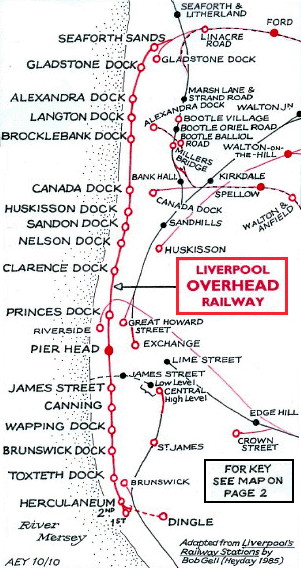 Brunswick Dock was located to the east of its namesake on the west side of Sefton Street towards the southern end of the Liverpool dock system. Just to the south of the LOR station, on the east side of Sefton Street, was the South Docks Goods station of the Lancashire & Yorkshire Railway which had opened in 1882. Brunswick Dock was located to the east of its namesake on the west side of Sefton Street towards the southern end of the Liverpool dock system. Just to the south of the LOR station, on the east side of Sefton Street, was the South Docks Goods station of the Lancashire & Yorkshire Railway which had opened in 1882.
The station was elevated above the line on iron pillars. It had two platforms both of which were accessed from street level by stairways. Both platforms were provided with timber waiting shelters.
At the time of opening Brunswick Dock had a frequent service of electric trains that ran to and from Alexandra Dock. On 30 April 1894 a northern extension opened to Seaforth Sands which became the northern terminus for train services.
The line was an immediate success but its passenger numbers dropped off after 6.00pm when most of the dock workers had returned home. The LOR believed that they needed to tap into residential areas and to achieve that aim they built an extension to Dingle which opened on 21 December 1896. From this date Langton Dock had a frequent service running between Seaforth Sands and Dingle.
In 1897 the Brunswick Dock Goods station was opened by the London & North Western Railway. It was also on the eastern side of Sefton Street just to the north of the South Docks Goods station.
On 2 July 1905 an extension was opened from Seaforth Sands to Seaforth & Litherland on the Lancashire & Yorkshire Railway's (LYR) Liverpool and Southport line. From that date many northbound services ran through to the LYR station. The LYR had electrified that line in 1904 and saw opportunities for through running of services between Southport & Dingle. The LYR had electrified their system with live rails laid to the side of the running rails. So that through trains could run the LOR altered its live rails accordingly.
The LYR introduced a Southport and Dingle service on 2 February 1906 using specially constructed lightweight electric units. The LYR services called at Brunswick Dock station and ran hourly in each direction. Later that year the LYR also introduced a through service between Aintree and Dingle but it was not a success and was discontinued in September 1908. For the race meetings that were held at Aintree through services continued to run. The Southport and Dingle service was withdrawn in August 1914 never having lived up to expectations. Through tickets between Canada Dock and Southport line stations continued to be sold passengers having to change trains at Seaforth & Litherland.
 By the early 1920s the LOR was carrying millions of passengers every year and many of them were passing through Brunswick Dock station. The line was used by dock labourers, sailors, shoppers, businessmen and also tourists. The LOR had soon recognised that the commanding views from their trains of the dock estate and the ships within it were an attraction; they therefore provided day tickets allowing passengers to alight and board trains at any of the stations along the line, with unlimited travel. Locally the line became known as the ‘Ovee’ or the ‘Dockers’ Umbrella’. The later name referred to the fact that dockers would walk under its structure in inclement weather to avoid the rain. By the early 1920s the LOR was carrying millions of passengers every year and many of them were passing through Brunswick Dock station. The line was used by dock labourers, sailors, shoppers, businessmen and also tourists. The LOR had soon recognised that the commanding views from their trains of the dock estate and the ships within it were an attraction; they therefore provided day tickets allowing passengers to alight and board trains at any of the stations along the line, with unlimited travel. Locally the line became known as the ‘Ovee’ or the ‘Dockers’ Umbrella’. The later name referred to the fact that dockers would walk under its structure in inclement weather to avoid the rain.
As a major Atlantic-facing seaport, Liverpool had been crucial to the war effort during the Great War, and the LOR had played its part by moving millions around the dock system. In the Second World War it was called upon to do so again, but in this conflict Liverpool found itself directly in the firing line. Between December 1940 and January 1942 Liverpool was bombed by the German Luftwaffe; the worst periods of bombing were in December 1940 and May 1941. The LOR suffered badly and was hit many times, and Brunswick Dock received a direct hit on 26 September 1940. The South Dock Goods and Brunswick Dock Goods stations were also hit on that day and completely destroyed. Because the LOR was an essential transport network for the docks the line was patched up each time it was damaged, and trains were reintroduced as quickly as possible. Brunswick Dock station was rebuilt but in a more simple style. South Docks Goods and Brunswick Dock Goods were not rebuilt. The last Grand National meet was in 1940, after which the race was suspended owing to the war, and it did not resume until 1947.
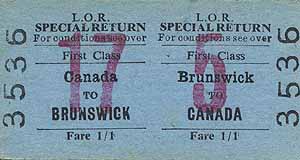 After the war the LOR was as busy as ever. There was a boom in trade at the docks, and the railway reaped the benefit. The Grand National was run again on 29 March 1947 - it was moved to a Saturday: before the war it had been run on a Friday - and trains operated between Dingle and Aintree for the first time since 1940. They continued to do so for every Grand National until the LOR closed. After the war the LOR was as busy as ever. There was a boom in trade at the docks, and the railway reaped the benefit. The Grand National was run again on 29 March 1947 - it was moved to a Saturday: before the war it had been run on a Friday - and trains operated between Dingle and Aintree for the first time since 1940. They continued to do so for every Grand National until the LOR closed.
The railways of Great Britain were nationalised on 1 January 1948, but the LOR remained independent. For the Grand National on the 26 March 1955 the LOR ran nine trains from Brunswick Dock (originating from Dingle) to Aintree and charged passengers one shilling single, or two shillings return. There were seven return workings which all ran forward to Dingle.
In 1955 an engineering survey was carried out on the iron structure of the LOR. It was discovered that the deck plates on which the tracks were mounted were severely corroded, owing both to the effects of the weather and of smoke from steam engines operated on a dock railway beneath the LOR. The plates needed to be replaced within a few years, and the cost was estimated at £2 million. The LOR did not have the funds to carry out the work and, although the line was still carrying millions of passengers every year, complete closure of the line was proposed. Suggestions were put forward for saving the line, including taking it into municipal ownership, but none was successful, and the line closed completely on Sunday 30 December 1956.
Brunswick Dock station was demolished in the summer of 1957.
To see the other
stations on the Liverpool Overhead Railway click on the station
name: Dingle,
Herculaneum Dock,
Toxteth Dock,
Wapping Dock,
Canning, James
Street, Pier Head,
Princes Dock,
Clarence Dock,
Nelson Dock,
Sandon
Dock, Huskisson
Dock, Canada
Dock, Brocklebank
Dock,
Langton
Dock, Alexandra
Dock, Gladstone
Dock & Seaforth
Sands
See also: Brunswick Dock Goods and South Docks Goods stations
Click here
for a brief history of the Liverpool Overhead Railway
|

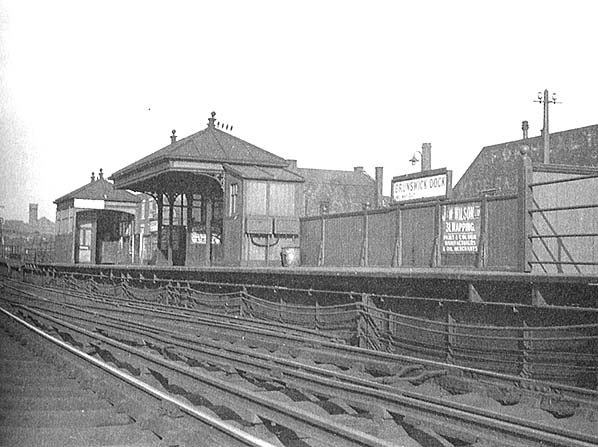
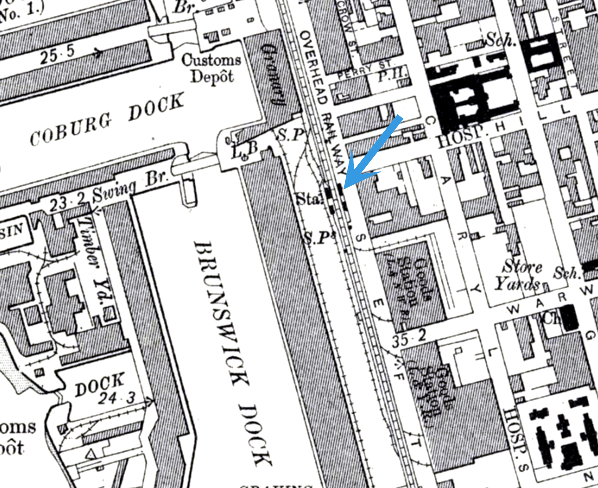
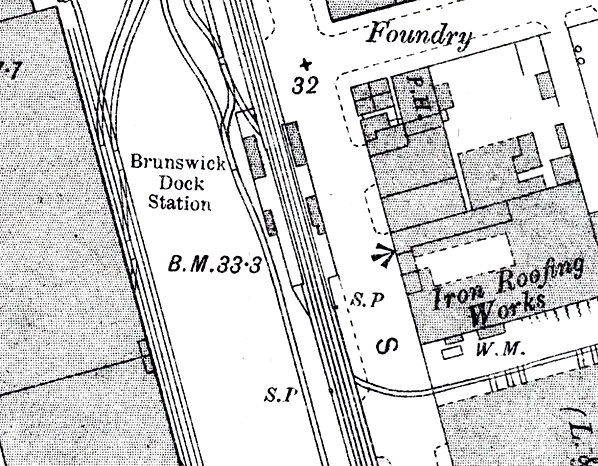
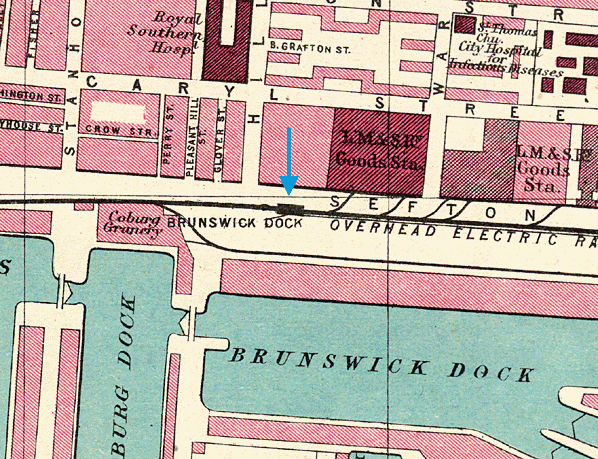


 Home Page
Home Page  Brunswick Dock was located to the east of its namesake on the west side of Sefton Street towards the southern end of the Liverpool dock system. Just to the south of the LOR station, on the east side of Sefton Street, was the South Docks Goods station of the Lancashire & Yorkshire Railway which had opened in 1882.
Brunswick Dock was located to the east of its namesake on the west side of Sefton Street towards the southern end of the Liverpool dock system. Just to the south of the LOR station, on the east side of Sefton Street, was the South Docks Goods station of the Lancashire & Yorkshire Railway which had opened in 1882.  By the early 1920s the LOR was carrying millions of passengers every year and many of them were passing through Brunswick Dock station. The line was used by dock labourers, sailors, shoppers, businessmen and also tourists. The LOR had soon recognised that the commanding views from their trains of the dock estate and the ships within it were an attraction; they therefore provided day tickets allowing passengers to alight and board trains at any of the stations along the line, with unlimited travel. Locally the line became known as the ‘Ovee’ or the ‘Dockers’ Umbrella’. The later name referred to the fact that dockers would walk under its structure in inclement weather to avoid the rain.
By the early 1920s the LOR was carrying millions of passengers every year and many of them were passing through Brunswick Dock station. The line was used by dock labourers, sailors, shoppers, businessmen and also tourists. The LOR had soon recognised that the commanding views from their trains of the dock estate and the ships within it were an attraction; they therefore provided day tickets allowing passengers to alight and board trains at any of the stations along the line, with unlimited travel. Locally the line became known as the ‘Ovee’ or the ‘Dockers’ Umbrella’. The later name referred to the fact that dockers would walk under its structure in inclement weather to avoid the rain. After the war the LOR was as busy as ever. There was a boom in trade at the docks, and the railway reaped the benefit. The Grand National was run again on 29 March 1947 - it was moved to a Saturday: before the war it had been run on a Friday - and trains operated between Dingle and Aintree for the first time since 1940. They continued to do so for every Grand National until the LOR closed.
After the war the LOR was as busy as ever. There was a boom in trade at the docks, and the railway reaped the benefit. The Grand National was run again on 29 March 1947 - it was moved to a Saturday: before the war it had been run on a Friday - and trains operated between Dingle and Aintree for the first time since 1940. They continued to do so for every Grand National until the LOR closed.